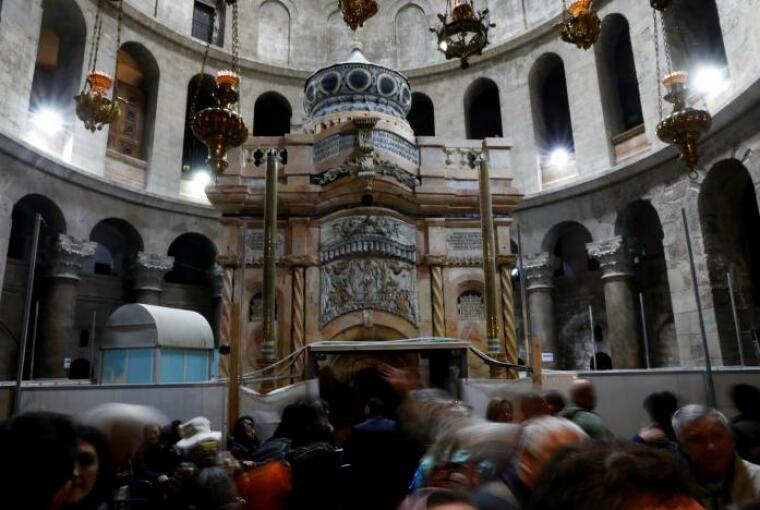Materials used for Jesus Christ's presumed tomb date back to ancient Roman era, experts reveal

Experts have confirmed that the construction materials used for the purported tomb of Jesus in Jerusalem date back to ancient Roman times, lending weight to traditional beliefs that Christ's may have been buried in what is now the current location of the Church of the Holy Sepulchre.
Scientific tests provided to National Geographic have shown that the mortar sampled from between the original limestone surface of the tomb and a marble slab that covers it dates back to around 345 A.D.
Historical accounts have indicated that the tomb was discovered and enshrined by Romans around 326 A.D. Previously, the earliest architectural evidence found in and around the tomb complex dated to the era of the Crusades, which makes it no older than 1,000 years.
Mortar samples from different locations from the Edicule, which houses the tomb, were tested by researchers from the National Technical University of Athens, and the results were recently released by Chief Scientific Supervisor Antonia Moropoulou.
The Telegraph noted that it was the first time such testing has been conducted at the Church of the Holy Sepulchre, which is one of the holiest sites in Christianity.
Moropoulou, who directed the Edicule restoration project, said that results of the tests were consistent with historical beliefs that the Romans built a monument at the presumed tomb during the era of the first Holy Roman Emperor Constantine, circa 326.
Samples taken from the southern wall yielded dates between 335 and 1570, which provide additional evidence for construction works from the Roman period, as well as a restoration work in the 16th century.
Mortar from the tomb entrance has been dated back to the 11th century, which aligns with the reconstruction of the Edicule after it was reportedly destroyed in 1009.
"It is interesting how [these] mortars not only provide evidence for the earliest shrine on the site, but also confirm the historical construction sequence of the Edicule," said Moropoulou.
When the researchers opened the tomb back in October 2016, they found an older, broken marble slab incised with a cross beneath the marble cladding that covers the "burial bed."
Some of the experts surmised that the older slab may have been laid down during the Crusader period, while others suggested that it may have already in place and broken when the church was destroyed in 1009.
The new results indicated that the lower slab was most likely mortared in place in the mid-fourth century under the orders of Emperor Constantine, which came as a surprise to those who are studying the history of the tomb.
"Obviously that date is spot-on for whatever Constantine did. That's very remarkable," said archaeologist Martin Biddle, who published a seminal study on the history of the tomb in 1999.
According to Daily Mail, the full findings will be revealed in the documentary "Secrets of Christ's Tomb," which will be aired by the National Geographic Channel in the UK on Dec. 25.
 Christians don't have to affirm transgenderism, but they can’t express that view at work: tribunal
Christians don't have to affirm transgenderism, but they can’t express that view at work: tribunal Archaeology discovery: Medieval Christian prayer beads found on Holy Island
Archaeology discovery: Medieval Christian prayer beads found on Holy Island Presbyterian Church in America votes to leave National Association of Evangelicals
Presbyterian Church in America votes to leave National Association of Evangelicals Over 50 killed in 'vile and satanic' attack at Nigerian church on Pentecost Sunday
Over 50 killed in 'vile and satanic' attack at Nigerian church on Pentecost Sunday Ukrainian Orthodox Church severs ties with Moscow over Patriarch Kirill's support for Putin's war
Ukrainian Orthodox Church severs ties with Moscow over Patriarch Kirill's support for Putin's war Islamic State kills 20 Nigerian Christians as revenge for US airstrike
Islamic State kills 20 Nigerian Christians as revenge for US airstrike Man who served 33 years in prison for murder leads inmates to Christ
Man who served 33 years in prison for murder leads inmates to Christ


 Nigerian student beaten to death, body burned over ‘blasphemous’ WhatsApp message
Nigerian student beaten to death, body burned over ‘blasphemous’ WhatsApp message 'A new low': World reacts after Hong Kong arrests 90-year-old Cardinal Joseph Zen
'A new low': World reacts after Hong Kong arrests 90-year-old Cardinal Joseph Zen Iran sentences Christian man to 10 years in prison for hosting house church worship gathering
Iran sentences Christian man to 10 years in prison for hosting house church worship gathering French Guyana: Pastor shot dead, church set on fire after meeting delegation of Evangelicals
French Guyana: Pastor shot dead, church set on fire after meeting delegation of Evangelicals ‘Talking Jesus’ report finds only 6% of UK adults identify as practicing Christians
‘Talking Jesus’ report finds only 6% of UK adults identify as practicing Christians Mission Eurasia ministry center blown up in Ukraine, hundreds of Bibles destroyed: 'God will provide'
Mission Eurasia ministry center blown up in Ukraine, hundreds of Bibles destroyed: 'God will provide' Church holds service for first time after ISIS desecrated it 8 years ago
Church holds service for first time after ISIS desecrated it 8 years ago Burger King apologizes for 'offensive campaign' using Jesus' words at the Last Supper
Burger King apologizes for 'offensive campaign' using Jesus' words at the Last Supper Uganda: Muslims abduct teacher, burn him inside mosque for praying in Christ’s name
Uganda: Muslims abduct teacher, burn him inside mosque for praying in Christ’s name